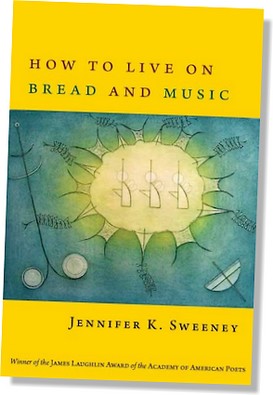Issue 2 - Winter 2010 Reviews Anxious Music Blood Dazzler Cities of Flesh and the Dead Crazy Love Cures and Poisons Dark Card and Mom's Canoe Fire Pond How to Live on Bread and Music Mister Skylight Paternity Perpetual Care Pictures in the Firestorm Rhapsody of the Naked Immigrants Rock Vein Sky Six Lips Slaves to Do These Things Slide Shows The Air around the Butterfly The Guilt Gene the nested object Interviews
 |
Jennifer K. Sweeney’s second collection of poetry How to Live on Bread and Music consists of five sections, two of them being multi-page poems, which are somewhat unusual as longer poems are notoriously more difficult to maintain, but Sweeney manages to avoid the common pitfalls of longer works with ease. Both of her longer poems radiate with fresh imagery, clever word choice, and an uncommon strength of metaphor. Clearly Sweeney is one of the brightest stars in emerging poetry. Her multi-page poem, “The Listeners” recounts the poet’s childhood with her father and music. Song lyrics are embedded seamlessly into the stanzas and each moment feels very carefully wrought. Sweeney moves from the abstract to more narrative moments:
Perhaps the most immediate trait of Sweeney’s work is the rich language one finds in her poetry coupled with a very precise use of metaphor. Throughout this impressive second collection we find a wealth of strong imagery, and an intense focus no matter what the subject. There are no weak poems in this collection; each poem dazzles in its own way. In her poem “Weathering” her gift of precision is on display:
Sweeney is never more strong than in the poem “In Flight,” the first poem in section five. Here she begins with legend and ends with a mysterious wisdom that holds the reader’s imagination in suspension. It is in moments like this where the world’s nature and all its subtle beauty are brought to the forefront. Sweeney captures that notion of being born in the air and turns back to the reader for a moment to pose the fascinating question:
Sweeney’s work has already garnered a lot of attention. Her first book, Salt Memory won the 2006 Main Street Rag Poetry Award and this most recent collection won the 2009 James Laughlin Award of the Academy of American Poets. In short, this collection rings with thought-provoking images and the silence she employs is noticeably well-thought out. Sweeney is one of those rare poets who can take a subject and make it true. Through careful technique she brings each poem to life and the music we hear is truly inspired.
Reviewed by Tasha Cotter. |
